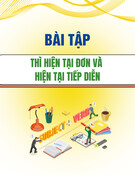
TNU Journal of Science and Technology
229(03): 20 - 26
http://jst.tnu.edu.vn 20 Email: jst@tnu.edu.vn
A STUDY ON EFFECTIVENESS OF INDUCTIVE METHOD IN TEACHING
GRAMMAR TO THE FIRST YEAR NON-ENGLISH MAJOR STUDENTS
AT THAI NGUYEN UNIVERSITY OF SCIENCES
Bui Thi Ngoan*
TNU - University of Sciences
ARTICLE INFO
ABSTRACT
Received:
25/5/2023
Grammar is one of the three important aspects of knowledge in English
which plays an important role in learners' four skills, particularly
writing and speaking skills. There are many different ways of teaching
grammar, but this study only investigates the effectiveness of inductive
method in teaching grammar. The object of the research is 60 first-year
non- English language major students at Thai Nguyen University of
Sciences. The students were randomly divided into 2 groups
(experimental group and control group), each group consisted of 30
students. Before conducting the study, students of both groups were
given a pre-test to ensure that the input ability of students in the two
groups was not different. After that, students of experimental group
were taught grammar with inductive method. In contrast, deductive
method was used for the control group. At the end of a semester,
students of both groups took a post- test. The results of the tests were
compared to evaluate the effectiveness of inductive method. The study
results showed that both groups had progress, but the results of the
experimental group were higher than that of the control group.
Revised:
31/7/2023
Published:
31/7/2023
KEYWORDS
Grammar
Inductive
Deductive
Writing skills
Speaking skills
NGHIÊN CỨU TÍNH HIỆU QUẢ CỦA PHƯƠNG PHÁP QUY NẠP TRONG
DẠY NGỮ PHÁP CHO SINH VIÊN KHÔNG CHUYÊN NGỮ NĂM THỨ NHẤT
TẠI TRƯỜNG ĐẠI HỌC KHOA HỌC – ĐẠI HỌC THÁI NGUYÊN
T N
-
THÔNG TIN BÀI BÁO
TÓM TẮT
Ngày nhận bài:
25/5/2023
Ngữ pháp là một trong ba khía cạnh kiến thức quan trọng trong tiếng Anh,
đóng vai trò lớn đối với bốn kỹ năng, đặc biệt là kỹ năng viết và kỹ năng
nói của người học. Có rất nhiều cách giảng dạy ngữ pháp khác nhau, tuy
nhiên, nghiên cứu này chỉ tập trung làm rõ tính hiệu quả của phương pháp
quy nạp. Đối tượng nghiên cứu là 60 sinh viên không chuyên ngữ năm thứ
nhất của trường Đại học Khoa học – Đại học Thái Nguyên. Các sinh viên
được chia ngẫu nhiên thành hai nhóm (nhóm thực nghiệm và nhóm đối
chứng), mỗi nhóm gồm 30 sinh viên. Trước khi tiến hành nghiên cứu, sinh
viên của cả hai nhóm đượ làm ài i m tra đ đảm ảo năng lự đ u vào
ủa sinh viên hai nhóm là h ng ó sự khác biệt. au đó, sinh viên ủa
nhóm thự nghiệm s đượ học ngữ pháp theo phương pháp quy nạp.
Ngượ lại, sinh viên nhóm đối hứng s được họ theo phương pháp
diễn dị h. ết th ỳ họ , sinh viên ả hai nhóm làm ài i m tra đ u ra
ài i m tra tương tự như i m tra đ u vào . ết quả ủa á ài i m tra
s đượ so sánh đ đánh giá t nh hiệu quả của phương pháp quy nạp. ết
quả nghiên ứu ho thấy ả hai nhóm đều ó sự tiến ộ, tuy nhiên, ết quả
ủa nhóm thự nghiệm ao hơn so với nhóm đối hứng.
Ngày hoàn thiện:
31/7/2023
N ày đă :
31/7/2023
TỪ KHÓA
Ngữ pháp
Quy nạp
Diễn dịch
Kỹ năng viết
Kỹ năng nói
DOI: https://doi.org/10.34238/tnu-jst.8014
*Email: bngoan.cna.k34@gmail.com

TNU Journal of Science and Technology
229(03): 20 - 26
http://jst.tnu.edu.vn 21 Email: jst@tnu.edu.vn
1. Introduction
Language plays an important role which is considered a tool for people to provide and
exchange information with each other. Among three aspects of knowledge, grammar is a crucial
component because sentences cannot be formed correctly and comprehensively without
grammatical rules. In fact, there were a lot of researchers who investigated and discussed on the
significance of grammar in language acquisition. According to Cook [1], grammar is the centre of
language. Huang [2] claimed that teaching and instructing grammar helped learners to improve
their linguistic competence. Ellis [3] also admitted that grammar instruction could assist students
improve their language proficiency and accuracy, make it easier for them to internalize the
syntactic structure a foreign language, and help them become more fluent. Therefore, the main
purpose of teaching grammar is to ensure that learners can understand and construct sentences
correctly and apply those grammatical rules to different situations.
According to Nunan [4], grammar is a set of rules to order words in the sentences and
sentences are only formed correctly if they follow the grammatical rules. In spite of its importance,
grammar is always considered an isolated section which is taught separately and learners only try
to remember rules and tips leading to the fact that learners do not know when and how to use
grammar for different situations. That is also one of reasons why most English learners in Vietnam
do very well on multiple-choice grammar tests, but when taking oral or writing tests, they often
make grammatical mistakes or sometimes they find it difficult to form sentences and express their
ideas. Therefore, learners tend to be better at recognizing rather than using.
This problem can only solved by considering other teaching methods. Deductive and
inductive methods are two effective ways in instructing grammar. Deductive teaching method is
often called top-down approach which is used widely in EFL classrooms. The rules are given first
and illustrative examples are presented later on. Finally, students apply the rules to produce their
own examples. This process shows that grammar is taught from the general to specific which was
pointed out by Fortune [5] and Erlam [6]. By contrast, in inductive method, Richards et al. [7]
claimed that grammatical rules are not instructed directly, but they are discovered through
learners' experience of using the language. Teachers will give examples at the beginning of the
lesson and ask students to analyze examples to find out the grammar rules on their own. Then,
teachers will conclude and give correct rules as well as grammar structures. Lastly, learners will
write their own examples. It can be seen that the inductive teaching is a student-centered learning
method and enables learners to be practiced and involved in the language they are studying [8],
[9]. Through this method, learners can remember and use grammar more properly when they
examine examples and discover rules themselves.
There were a lot of studies investigating the effectiveness of these two methods. Al- Emami [10]
investigated the impact of the inductive and deductive methods on teaching relative clause. Dang
and Nguyen [11] and Alzu’ i, M. A. [12] also ondu ted resear hes to see whi h approa h is etter.
The findings revealed that the inductive method had positive influences on teaching grammar.
In terms of students at Thai Nguyen University of Sciences, teaching grammar still plays an
important role and a lot of learners get troubles in doing grammar tests and using grammar in
speaking and writing. So how can students learn, remember, understand and apply aspects of
grammar more easily? Deduction and induction are two popular methods in teaching grammar in
Vietnam; however, deductive method seems to be used more in EFL classroom. Therefore, this
study investigates the effectiveness of inductive method in teaching grammar to see whether it
has positive impa ts on students’ ability and eventually choose the suitable method for students at
Thai Nguyen University of Sciences.
The study aimed at answering the question:
- What is the effect of inductive method on teaching English tenses in comparison with
deductive method?

TNU Journal of Science and Technology
229(03): 20 - 26
http://jst.tnu.edu.vn 22 Email: jst@tnu.edu.vn
2. Methods
2.1. Participants
Participants of the study were 60 students of two classes at Thai Nguyen University of
Sciences. Almost all participants come from mountainous area; they have been learning English
for seven to nine years. They already learnt about basic grammar before enrolling at university.
The participants were divided into two groups as a control group and an experimental group.
Each group included 30 students.
2.2. Data collection instruments
Pre-tests and post-tests were designed to evaluate students’ a ility a out using different tenses
in English. There are two kinds of test including the recognition test and production test. The
score was marked on a 10-point scale.
The recognition test was used to examine how well students realised the rules of tenses,
correct forms of verbs, correct orders in statement and in questions. This test included 20 four-
option multiple-choice questions and each question has one correct answer. Students had to do
the test in 10 minutes. The score of this test was based on the number of correct answers. The
data from this test would help the resear her evaluate the parti ipants’ re ognition a ility a out
different tenses in English.
In terms of the production test, it consisted of two tests which were writing test and speaking
test. The produ tion tests aimed at evaluating parti ipants’ a ility to use grammar in spea ing
and writing. About writing test, participants were required to rearrange the order of the given
words to make a correct sentence (10 questions, 5 points) and translate Vietnamese statements
into English using suitable tenses (10 questions, 5 points). About speaking test, students were
asked to answer questions about familiar topics which they were introduced during the treatment
period. tudents’ performan es were evaluated ased on how well they used the tenses in English
(20 questions, 10 points).
2.3. Procedure of data collection
A quasi-experimental design was used for the present study. The research followed these
following steps:
First of all, students of both groups were given pre-tests for checking their ability. The pre-test
was used to see whether all students of both groups were homogeneous in their knowledge of
grammar before starting research.
After taking pre-tests, learners in experimental group were instructed grammar through
inductive method. Whereas, students in control group were taught grammar by deductive method.
Finally, students of control and experimental groups were given two post-tests in order to
compare the range of improvement between them. The post-tests were the same format, level and
language to the pre-tests to be able to evaluate accurately the differences between both groups in
pre-tests and post-tests.
This study concentrated on tenses in English so other aspects of grammar, pronunciation were
skipped.
2.4. Teaching procedure
The students of both groups were introduced tenses in English during a semester. While
experimental group was instructed inductively, deductive was used for the control group. Each
group was taught through different steps.
Indu tive approa h: Examples → Pra ti e → Rules
TREATMENT
POST-TEST
PRE-TEST

TNU Journal of Science and Technology
229(03): 20 - 26
http://jst.tnu.edu.vn 23 Email: jst@tnu.edu.vn
Dedu tive approa h: Rules → Examples → Pra ti e
After being introduced grammar, students were asked to work in pair to do exercises in terms
of recognition exercises and production exercises. Students were carefully instructed by the
teacher who would give recommendations if necessary. This step helped students improve their
grammar comprehension and production.
3. Results and discussion
3.1. Comparison of two groups on pre-test
3.1.1. The data from recognition test
Table 1 compares the scores of both groups from recognition pre-test. The results showed that
the difference between control group and experimental group was negligible. The average score
of experimental group was 6.4 which is a bit less than that of control group (6.4333). Table 2
indicates that there was not much difference about the score range between two groups. It means
that the recognition ability of students in both groups was similar.
Table 1. Comparison of two groups on regconition pre-test
Groups
Average number of correct answers
Percentage
Score
Experiental group
12.8
64
6.4
Control group
12.86
64.4
6.44
Table 2. Comparison of two groups on score range (pre-test)
Groups
Score range
Experiental group
Control group
Number
Percentage
Number
Percentage
4.0 - < 5.5
3
10
3
10
5.5 - < 7.0
16
53.34
15
50
7.0 - < 8.5
9
30
11
36.66
8.5 - < 10
2
6.66
1
3.34 %
3.1.2. The data from production test
In terms of production writing test, 2 tests were designed which were writing test and
speaking test to see if there were any differences between these skills. Table 3 demonstrates that
students of both group did task 1 better than task 2 and both groups witnessed the similarities
about the scores.
Table 3. Comparison of two groups on production writing test (pre-test)
Groups
Score
Total score
Task 1
Task 2
Experiental group
2.65
2
4.65
Control group
2.6
2.067
4.667
The speaking pre-test etween two groups was omputed to show that students’ produ tion
ability in oral tests was similar as shown in table 4. The average scores of experimental group and
control group were 4.25 and 4.23 respectively. In comparison with writing test, the results from
speaking test was a bit lower. The scores of writing and speaking test were both under 5 points.
Table 4. Comparison of two groups on production speaking test (pre-test)
Groups
Score
Experiental group
4.25
Control group
4.23
After analysing the results from recognition test and production test, it revealed that students
at Thai Nguyen University of Sciences could realise tenses in English better than produce them in
speaking and writing.

TNU Journal of Science and Technology
229(03): 20 - 26
http://jst.tnu.edu.vn 24 Email: jst@tnu.edu.vn
3.2. Comparison of two groups on pre-test and post-test
3.2.1. The data from recognition test
Table 5 showed the comparison of the results from recognition pre-test and post-test of both
groups. In comparison with the pre-test, post test was experienced a higher result; however,
students of experimental group achieved better scores. The score of experimental and control
groups increased from 6.4 to 7.95 and from 6.43 to 7.4 respectively.
Table 5. Comparison of two groups on regconition pre-test and post-test
Groups
Average number of correct answers
Score
Pre-test
Post-test
Pre-test
Post-test
Experiental group
12.8
15.9
6.4
7.95
Control group
12.86
14.8
6.44
7.4
Table 6. Comparison of two groups on score range in pre-test and post-test
Groups
Score range
Experiental group
Control group
Pre-test
Post-test
Pre-test
Post-test
4.0 - < 5.5
3
0
3
0
5.5 - < 7.0
16
3
15
9
7.0 - < 8.5
9
16
11
16
8.5 - < 10
2
11
1
5
It an also e seen from ta le 6 that there was dramati hanges in student’s s ore range. Post-
test was seen more students getting score from 7.0 to 10 and there was no under 5.5-score. Both
groups had the same number of students who had achieved 7.0 to 8.5, at 16. It is noteworthy that
the experimental group was seen an increase in the number of students getting scores from 8.5-
10. Experimental group had doubled the control group, with 11 and 5 respectively.
To sum up, applying both deductive and inductive methods had positive effects on teaching
grammar. However, inductive teaching method helped students improve their scores in grammar
tests better than deductive one.
3.2.2. The data from production test
As can be seen from table 7, production writing post-test saw a considerable increase in
students’ s ores of oth groups. The s ore of ontrol group was 5.966667 whi h was mu h lower
than that of experimental group, at 6.7 points. It can be seen clearly from the table that students
were better at rearranging words than translating.
Table 7. Comparison of two groups on writing pre-test and post-test
Groups
Pre-test score
Total score
Post-test score
Total score
Task 1
Task 2
Task 1
Task 2
Experiental group
2.65
2
4.65
3.73
2.9667
6.7
Control group
2.6
2.067
4.667
3.22
2.75
5.966667
Although both groups witnessed a more positive result in speaking post-test, the experimental
group had a higher result in comparison with control group. Therefore, it could be concluded that
both deductive and inductive teaching methods were helpful in improving the learners’ produ tion
ability. The score of experimental group was 6.18 followed by control group, at 5.73 (table 8).
Table 8. Comparison of two groups on speaking pre-test and post-test
Groups
Pre-test score
Post-test score
Experiental group
4.25
6.18
Control group
4.23
5.73
As results obtained, it could be seen that although both writing test and speaking test were
seen a better result in post-test, students seemed to do better at writing test than speaking one.












![Bài tập thì hiện tại hoàn thành [kèm đáp án chi tiết]](https://cdn.tailieu.vn/images/document/thumbnail/2025/20251106/thuthao27062004/135x160/41601762420911.jpg)






![Tài liệu ôn tập Ngữ pháp tiếng Anh [chuẩn/mới nhất/tổng hợp]](https://cdn.tailieu.vn/images/document/thumbnail/2025/20250821/vuongdinhlinh1412@gmail.com/135x160/933_tai-lieu-on-tap-ngu-phap-tieng-anh.jpg)




